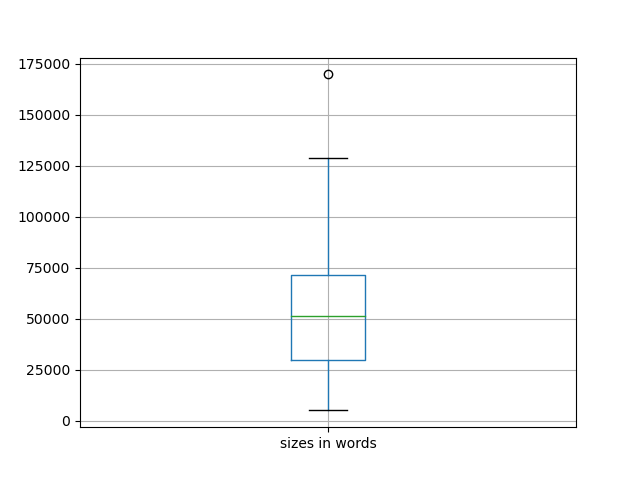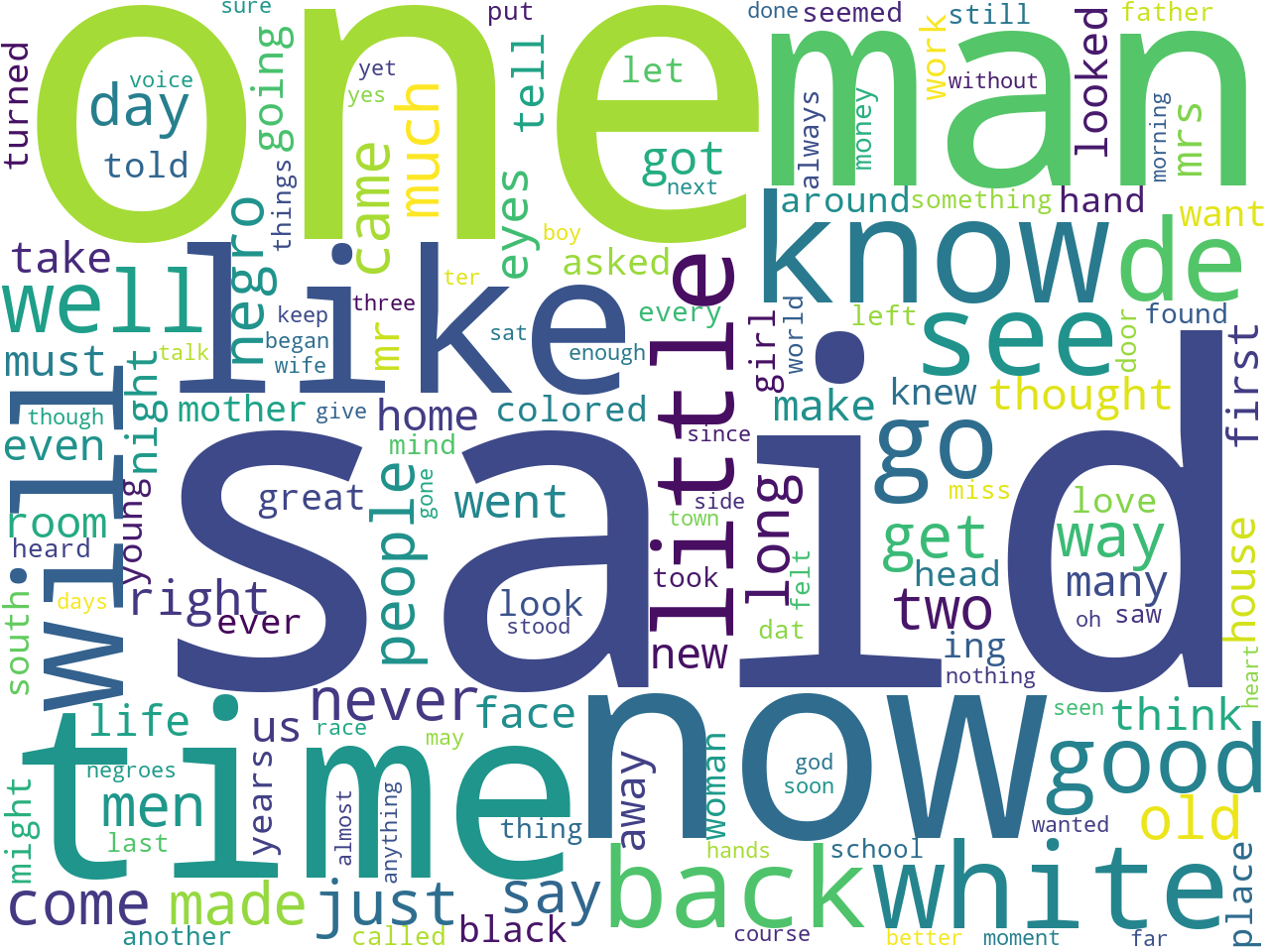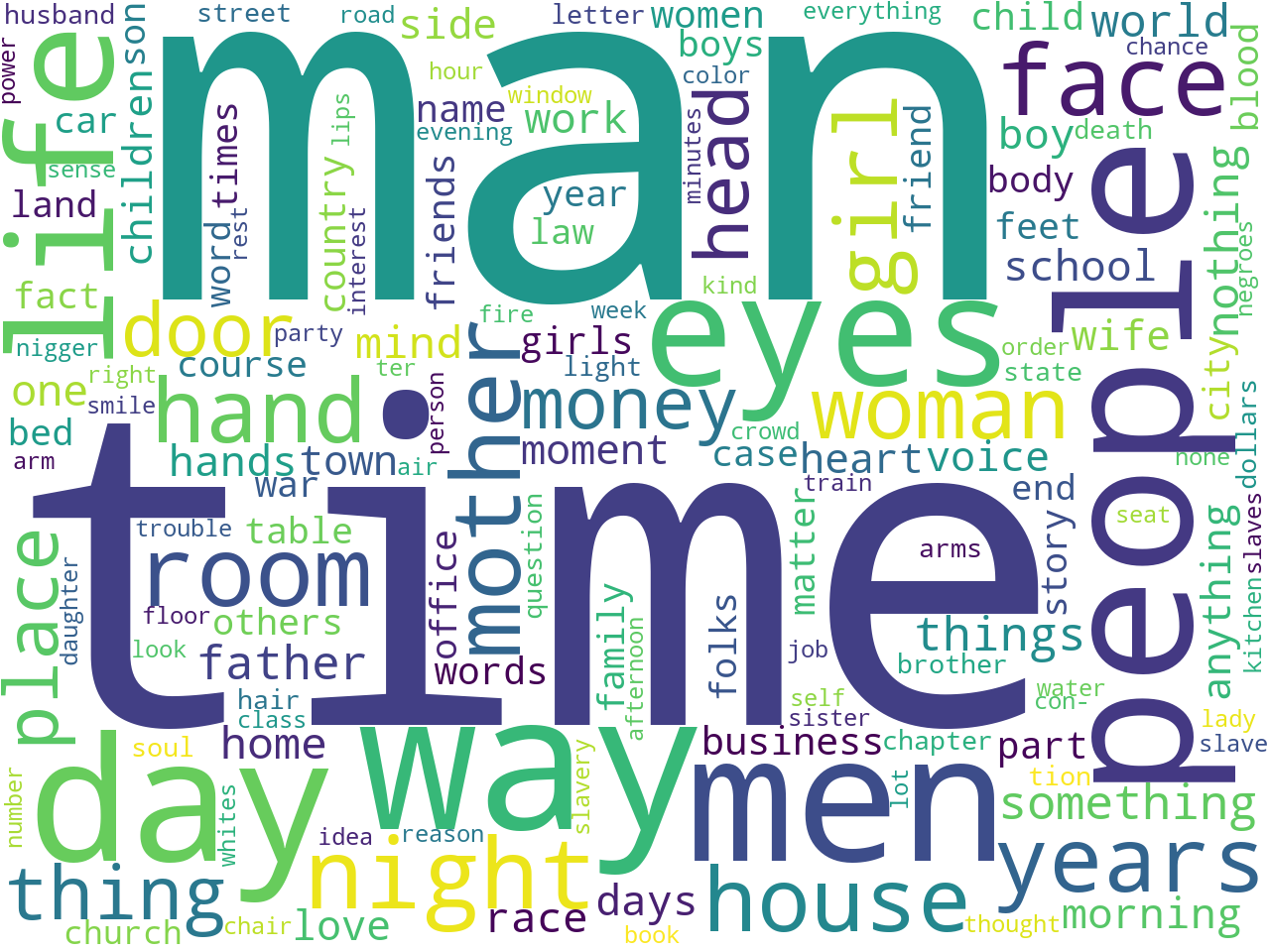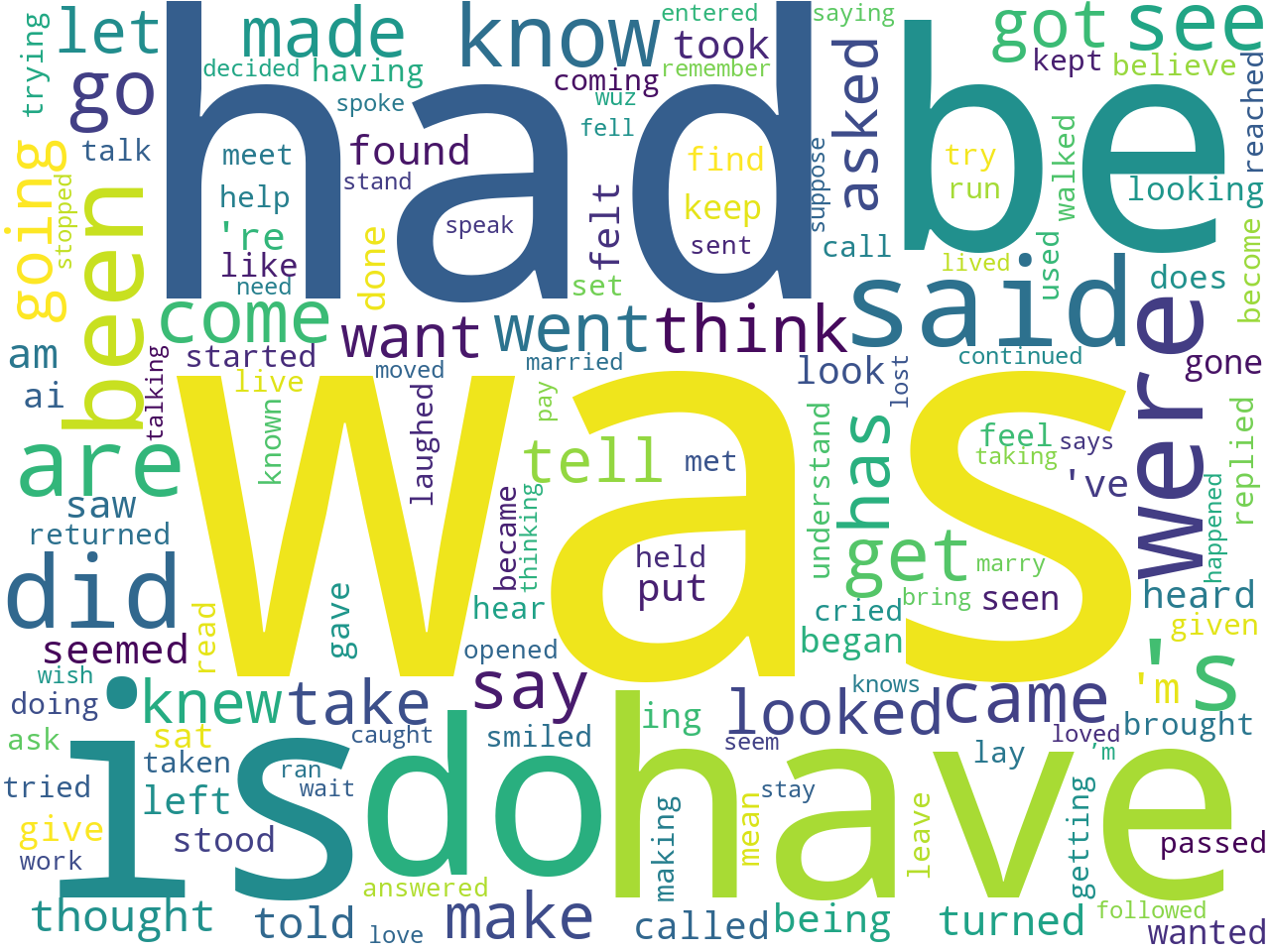africanAmericanFiction-from-hathi
Introduction
This is a Distant Reader "study carrel", a set of structured data intended to help the student, researcher, or scholar use & understand a corpus.
This study carrel was created on 2021-01-24 by Eric Morgan <emorgan@nd.edu>. The carrel was created using the Distant Reader trust process, and the input was a HaithTrust metadata (TSV) file locally cached with the name metadata.tsv. Given the metadata file, associated PDF documents where saved to a a cache and a second set of documents were saved to a set of plain text files. All of the analysis -- "reading" -- has been done against the plain text files. For example, a short narrative report has been created. This Web page is a more verbose version of that report.
All study carrels are self-contained -- no Internet connection is necessary to use them. Download this carrel for offline reading. The carrel is made up of many subdirectories and data files. The manifest describes each one in greater detail.
Size
The study carrel is 4,179,899 words long. Each item in the study carrel is, on average, 52,248 words long. If you dig deeper, then you might want to save yourself some time by reading a shorter item. On the other hand, if your desire is for more detail, then you might consider reading a longer item. The following illustrate the overall size of the study carrel.


Readability
On a scale from 0 to 100, where 0 is very difficult and 100 is very easy, the documents have an average readability score of 88. Consequently, if you want to read something more simplistic, then consider a document with a higher score. If you want something more specialized, then consider something with a lower score. The following illustrate the overall readability of the study carrel.


Word Frequencies
By merely counting & tabulating the frequency of individual words or phrases, you can begin to get an understanding of the carrel's "aboutness". Excluding "stop words", some of the more frequent words include:
said, one, man, now, time, like, know, will, white, see, de, back, little, go, good, well, just, way, come, get, people, came, two, never, much, old, men, made, day, say, negro, long, right, eyes, got, went, thought, mr, think, us, face, new, life, make, away, home, mrs, going, room, night
Using the three most frequent words, the three files containing all of those words the most are: 1) The case of Mrs. Wingate by Oscar Micheaux, 2) The story of Dorothy Stanfield, based on a great insurance swindle, and a woman! A novel by Oscar Micheaux, and 3) The homesteader : a novel by Oscar Micheaux ... ; illustrated by W.M. Farrow.
The most frequent two-word phrases (bigrams) include:
new york, white man, young man, white people, le baron, united states, colored people, old man, long time, one day, first time, white men, colored man, white folks, white band, dorothy stanfield, come back, emma lou, years ago, uncle jack, next morning, let us, one thing, jean baptiste, low grounds, take care, next day, came back, white woman, new orleans, young men, american negro, two years, last night, go back, thousand dollars, immediate jewel, hundred dollars, silver fleece, black man, negro preacher, mas querade, wooden god, jake said, said nothing, uncle jake, one side, san ction, breathe thunder, false measure
And the three file that use all of the three most frequent phrases are: 1) The case of Mrs. Wingate by Oscar Micheaux, 2) The story of Dorothy Stanfield, based on a great insurance swindle, and a woman! A novel by Oscar Micheaux, and 3) The black challenge.
While often deemed superficial or sophomoric, rudimentary frequencies and their associated "word clouds" can be quite insightful:


Keywords
Sets of keywords -- statistically significant words -- can be enumerated by comparing the relative frequency of words with the number of times the words appear in an entire corpus. Some of the most statistically significant keywords in the study carrel include:
new york, god, negro, south, man, chapter, old man, united states, negroes, negro man, little time, young white man, negro race, look, white man, like, southern white man, south carolina, little man, great man, good man, white, time, sam, new york city, new orleans, new england, good time, good, william, white south, white men, street, south america, poor man, mr. wilson, mr. johnson, ethel, de man, american negro, young man, young colored man, year, wife, white people, union, uncle jack, tell, southern, sandy
And now word clouds really begin to shine:

Topic Modeling
Topic modeling is another popular approach to connoting the aboutness of a corpus. If the study carrel could be summed up in a single word, then that word might be said, and The autobiography of an ex-colored man is most about that word.
If the study carrel could be summed up in three words ("topics") then those words and their significantly associated titles include:
- said - The story of Dorothy Stanfield, based on a great insurance swindle, and a woman! A novel by Oscar Micheaux
- man - The hindered hand: or, The reign of the repressionist By Sutton E. Griggs
- said - The waiters.
If your study carrel could be summed up in five topics, and each topic were each denoted with three words, then those topics and their most significantly associated files would be:
- said, like, know - The case of Mrs. Wingate by Oscar Micheaux
- man, said, white - Poor Ben : a story of real life by Lucretia H. Newman Coleman
- said, man, did - Worlds of color
- said, ah, don - Under the cottonwood; a saga of Negro life in which the history, traditions and folklore of the Negro of the last century are vividly portrayed. By Katheryn Campbell Graham
- en, ter, dat - The conjure woman by Charles W. Chesnutt
Moreover, the totality of the study carrel's aboutness, can be visualized with the following pie chart:

Noun & Verbs
Through an analysis of the study carrel's parts-of-speech, you are able to answer question beyonds aboutness. For example, a list of the most frequent nouns helps you answer what questions; "What is discussed in this collection?":
man, time, way, people, men, day, eyes, life, night, room, face, mother, years, hand, house, girl, woman, thing, door, place, head, money, something, father, things, nothing, world, mind, home, one, race, work, boy, morning, school, hands, days, voice, heart, side, moment, wife, town, love, anything, children, business, women, part, girls
An enumeration of the verbs helps you learn what actions take place in a text or what the things in the text do. Very frequently, the most common lemmatized verbs are "be", "have", and "do"; the more interesting verbs usually occur further down the list of frequencies:
was, had, be, is, have, do, said, were, been, did, 's, are, know, see, go, come, get, came, has, made, say, got, went, think, make, going, looked, take, let, tell, asked, want, knew, thought, 'm, told, am, turned, seemed, took, found, saw, being, put, 're, felt, 've, left, heard, called


Proper Nouns
An extraction of proper nouns helps you determine the names of people and places in the study carrel.
Mr., Mrs., de, South, Negro, Miss, God, dat, New, Joe, Negroes, Dr., Jake, John, Joan, William, Jim, Asher, Uncle, York, Jean, dey, North, Colonel, Tom, Sam, Jack, Wyeth, States, America, Aunt, June, Smith, Abe, Mimi, Mansart, Street, Marie, jes, Baron, Bob, Lou, Doctor, Lord, Vera, Bill, Sunday, Baptiste, United, Le
An analysis of personal pronouns enables you to answer at least two questions: 1) "What, if any, is the overall gender of my study carrel?", and 2) "To what degree are the texts in my study carrel self-centered versus inclusive?"
he, i, you, it, his, she, her, him, they, me, my, we, them, their, your, our, us, its, himself, herself, myself, themselves, 'em, one, itself, yourself, 's, mine, yours, hers, ourselves, yer, em, thy, theirs, thee, yuh, duh, yo, ye, tuh, ’s, ya, ours, him-, ex-, be-, hisself, withal, you're
Below are words cloud of the study carrel's proper & personal pronouns.


Adjectives & Verbs
Learning about a corpus's adjectives and adverbs helps you answer how questions: "How are things described and how are things done?" An analysis of adjectives and adverbs also points to a corpus's overall sentiment. "In general, is this study carrel positive or negative?"
white, little, other, good, old, more, great, many, own, young, black, few, much, colored, first, long, same, last, new, such, right, next, negro, big, small, poor, sure, free, best, most, large, better, glad, able, dear, dark, whole, full, true, happy, several, high, beautiful, ready, bad, least, only, open, hard, fine
not, n't, so, up, now, then, out, just, here, down, back, never, too, as, there, only, very, away, again, more, all, even, on, well, ever, in, still, over, always, off, much, soon, long, almost, most, once, right, far, home, yet, also, n’t, perhaps, around, together, enough, however, before, else, often


Next steps
There is much more to a study carrel than the things outlined above. Use this page's menubar to navigate and explore in more detail. There you will find additional features & functions including: ngrams, parts-of-speech, grammars, named entities, topic modeling, a simple search interface, etc.
Again, study carrels are self-contained. Download this carrel for offline viewing and use.
Thank you for using the Distant Reader.